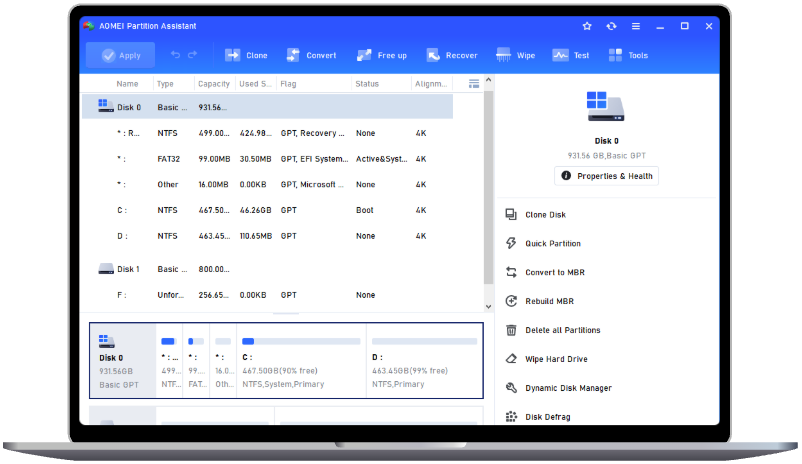How to Add a New Partition in Windows 11/10?
Partitioning your hard drive is a useful way to organize your data and manage storage more efficiently. This post provides a step-by-step tutorial on how to add a new partition in Windows 11 and 10, helping you effortlessly manage disk space.
Why Add New Partitions in Windows 11/10?
Creating new partitions allows you to separate your files, applications, and operating system into distinct sections, making it easier to manage and protect your data. For instance, you can dedicate one partition to your operating system and essential programs while using another for personal files like documents, photos, and videos. This not only helps you stay organized but also minimizes the risk of data loss in case of system crashes or malware attacks.
Additionally, partitioning is essential for advanced tasks like dual-booting multiple operating systems or setting up a dedicated partition for backups. So, how can we add a new partition to my drive? Don’t worry! This post will explore three methods to add a new partition in Windows 11/10, helping you effortlessly manage disk space.
How to Add a New Partition in Windows 11/10?
Method 1: Add a New Partition Using Professional Disk Management Software
If you want a user-friendly, risk-free way to add a new partition in Windows 11 or 10, third-party tools like AOMEI Partition Assistant are ideal. This software simplifies complex tasks with intuitive workflows, making it perfect for non-technical users. In addition to creating partitions, AOMEI Partition Assistant provides many practical features to manage disks, including splitting, resizing, merging, or formatting partitions.
★ Fully compatible with Windows 11/10/8.1/8/7 and Windows Server versions.
★ Provides advanced features to optimize your disk management.
★ Features an intuitive interface, making it accessible for both beginners and advanced users.
★ Offers comprehensive user guides and 24/7 customer support to assist users with any issues.
Here’s how to create a new partition in Windows 11.
Step 1. Install and launch AOMEI Partition Assistant; right-click the unallocated space or a partition with enough free space, then select Create Partition.
Step 2. Specify the size, file system, and drive letter of the new partition, and then click “OK” to continue.
Step 3. Finally, click “Apply” and “Proceed” to start the process.
Method 2: Add a New Partition via Windows Disk Management
Windows Disk Management is a built-in utility that provides a straightforward way to create and manage partitions in Windows 11/10. While it lacks some advanced features, it’s ideal for basic partitioning tasks.
Here’s how to add a new partition in Windows 11 or 10 using this tool.
Step 1. Right-click on “This PC” on your desktop and select “Manage”. Then, click “Disk Management” under Storage in the left pane.
Step 2. Check if there is available unallocated space to create a partition. If there’s unallocated space, skip to Step 4. If not, right-click on an existing partition with free space and select “Shrink Volume”.
Step 3. Enter the amount of space to shrink in MB and click on “Shrink” to continue.
Step 4. After shrinking, you’ll see unallocated space (labeled with a black bar). Right-click it and select “New Simple Volume”.
Step 5. In the New Simple Volume Wizard window, set the partition size, assign a drive letter, and choose a file system as needed. Then click Next to start the process.
Step 6. Finally, click Finish to complete creating a new partition in Windows 11/10.
If you still want to create another partition, repeat the steps above to create other partitions.
Method 3: Add a New Partition Using DiskPart
Advanced users comfortable with command-line tools can use DiskPart to create a new partition in Windows 11/10. This method offers granular control but requires precision—wrong commands can lead to unexpected errors. Follow these steps to create a new partition in Windows 11/10:
Step 1. Press “Win + R” and type “cmd” on the Run box, and press Enter to open the Command Prompt.
Step 2. Type the following commands and press Enter after each one.
- diskpart
- list disk
- select disk X (Replace X with the disk number.)
- create partition primary size=10000 (You can adjust the size of the partition as you like.)
- list partition
- select partition Y (Y stands for the partition number.)
- format fs=ntfs quick label="Backup Partition" (Format the partition in NTFS.)
- assign letter=G (Assign a drive letter to the partition you created)
Step 3. Finally, type exit to close the window.
Pro Tip: Create Multiple Partitions at Once
If you want create multiple partitions on a new hard drive at once, consider using the Quick Partition feature within AOMEI Partition Assistant. Here’s a step-by-step guide:
Step 1. Right-click the disk you want to partition and then select "Quick Partition" in the drop-down menu.
Step 2. In the "Quick Partition" window, you can specify the disk you want to partition, partition count, disk type, and other parameters.
Step 3. When all the settings are done, click the "Start Partitioning" button to perform one-key quick partition.
Conclusion
This post outlines three practical ways to add a new partition in Windows 11/10. For most users, AOMEI Partition Assistant is the safest and fastest option, especially when managing disks with complex needs. Whether you choose this powerful software or rely on Windows' built-in tools, always back up your data beforehand to avoid potential data loss. Ready to take control of your disk space? Follow this guide and enhance your user experience!
FAQs
Q1: How do I check if I have enough space to create a new partition?
You can open Disk Management to look for unallocated space (black bar) or check the free space on existing partitions. If no unallocated space exists, shrink an existing partition to free up space.
Q2: Why can’t I shrink a partition in Windows 11?
- The partition is FAT32 (Disk Management only supports shrinking NTFS or RAW partitions).
- There’s insufficient free space to shrink.
- Unmovable system files are located at the end of the partition.
Q3: Can I merge two partitions?
Yes. AOMEI Partition Assistant provides a safe and effective way to combine partitions or merge partitions with unallocated space.


